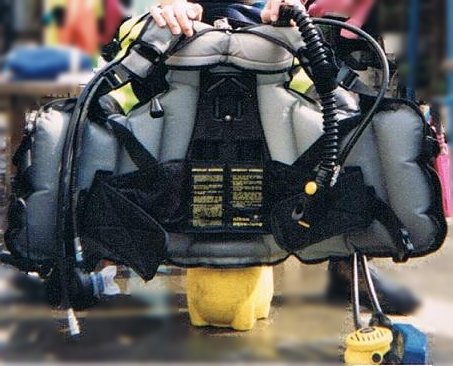Scuba diving
- Introduction to Scuba Diving
- Understanding the Underwater Environment
- Scuba Diving Techniques
- Scuba Diving Equipment in Detail
- Health and Fitness for Scuba Diving
- Advanced Diving Techniques
- Rescue and Emergency Procedures
- Dive Planning and Logistics
- Underwater Photography and Videography
- Specialized Diving
- Career Opportunities in Scuba Diving
- Legal and Ethical Considerations
Scuba Diving Equipment in Detail
Understanding Buoyancy Control Devices in Scuba Diving

Diving equipment for controlling buoyancy by volume adjustment.
Buoyancy Control Devices (BCDs) play a crucial role in scuba diving. They allow divers to control their buoyancy underwater, enabling them to ascend, descend, and hover at will. This article will delve into the different types of BCDs, their uses, and how to maintain and store them properly.
Role of the Buoyancy Control Device in Diving
A BCD is essentially a wearable vest that has an inflatable bladder. The diver can inflate or deflate this bladder to adjust their buoyancy. When the bladder is inflated, it increases the diver's volume without increasing their weight, making them less dense and causing them to float. Conversely, when the bladder is deflated, the diver's density increases, causing them to sink.
BCDs also serve as a mounting point for the diver's equipment, including the scuba tank and any accessory equipment like dive lights or underwater cameras.
Types of BCDs and Their Uses
There are three main types of BCDs: jacket style, back-inflate, and wing-and-backplate.
-
Jacket Style BCDs: These are the most common type of BCD. They are easy to use and provide a lot of buoyancy, making them ideal for beginners. The buoyancy is distributed around the diver, providing stability in the water.
-
Back-Inflate BCDs: These BCDs have the bladder located on the back of the diver. This design provides better horizontal trim in the water, making them popular with advanced divers. However, they can be a bit unstable on the surface.
-
Wing-and-Backplate BCDs: These are the most customizable type of BCD. They consist of a metal backplate, a wing-style bladder, and a harness. These BCDs are popular with technical divers due to their durability and modularity.
Maintaining and Storing BCDs
Proper maintenance and storage of your BCD can significantly extend its lifespan. After each dive, rinse your BCD thoroughly with fresh water to remove any salt, sand, or other debris. Inflate and deflate the BCD several times during the rinse to clean the inside of the bladder.
Every few months, you should do a more thorough cleaning. Inflate the BCD and add a BCD cleaner to the bladder. Swish it around and let it sit for a while, then rinse it out thoroughly.
When storing your BCD, keep it in a cool, dry place out of direct sunlight. It's best to store it partially inflated to keep the bladder from sticking together.
Using a BCD to Control Your Buoyancy
Mastering buoyancy control is one of the most important skills in scuba diving. By adding or releasing air from your BCD, you can control your position in the water column. Remember, small adjustments are key. It's better to make several small adjustments than one large one.
In conclusion, understanding your BCD is crucial to becoming a proficient scuba diver. By knowing the different types of BCDs, how to maintain them, and how to use them to control your buoyancy, you can ensure a safe and enjoyable dive.